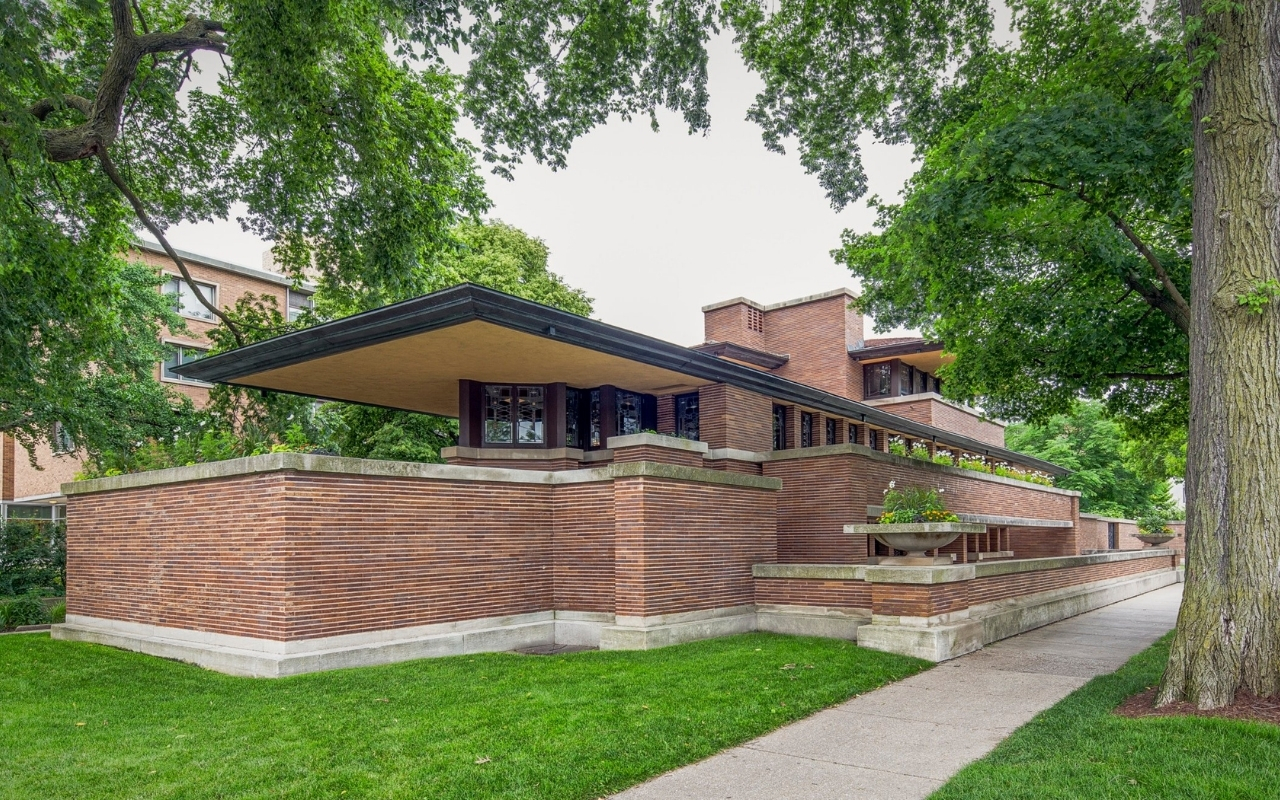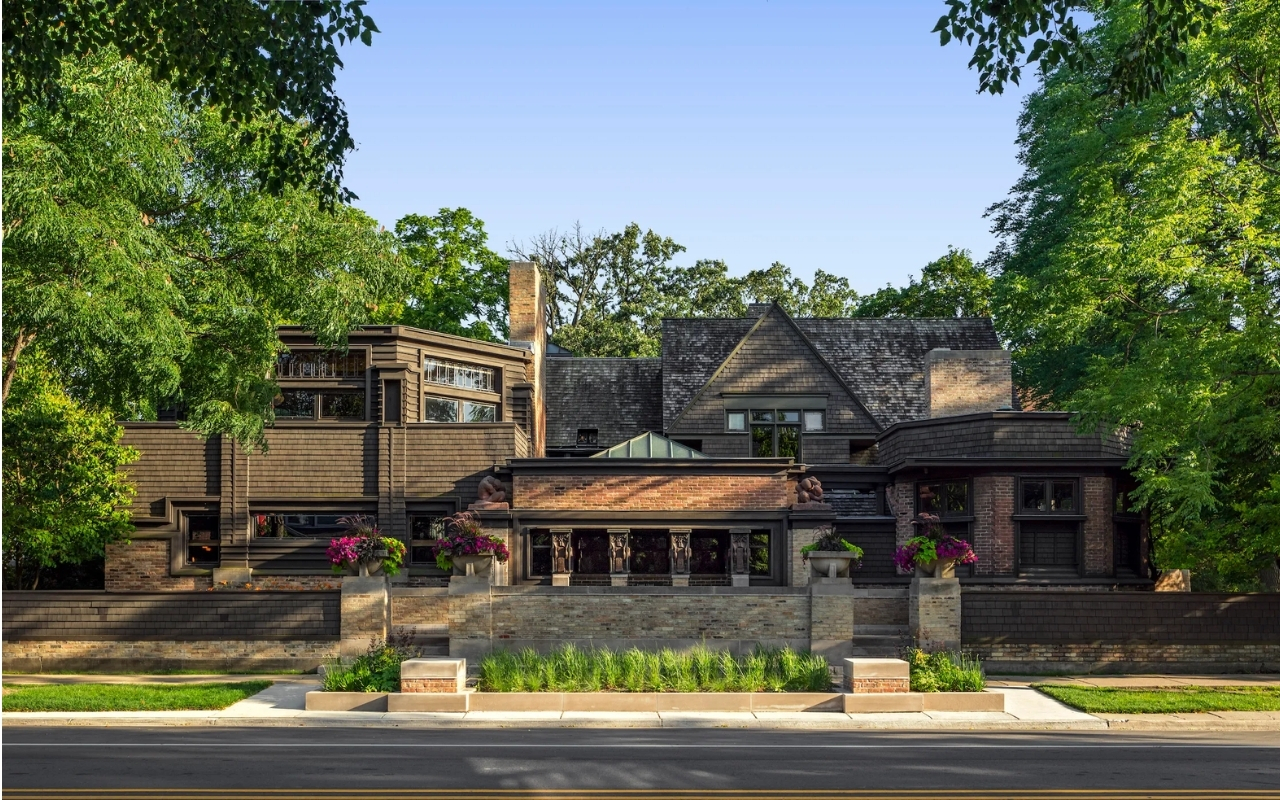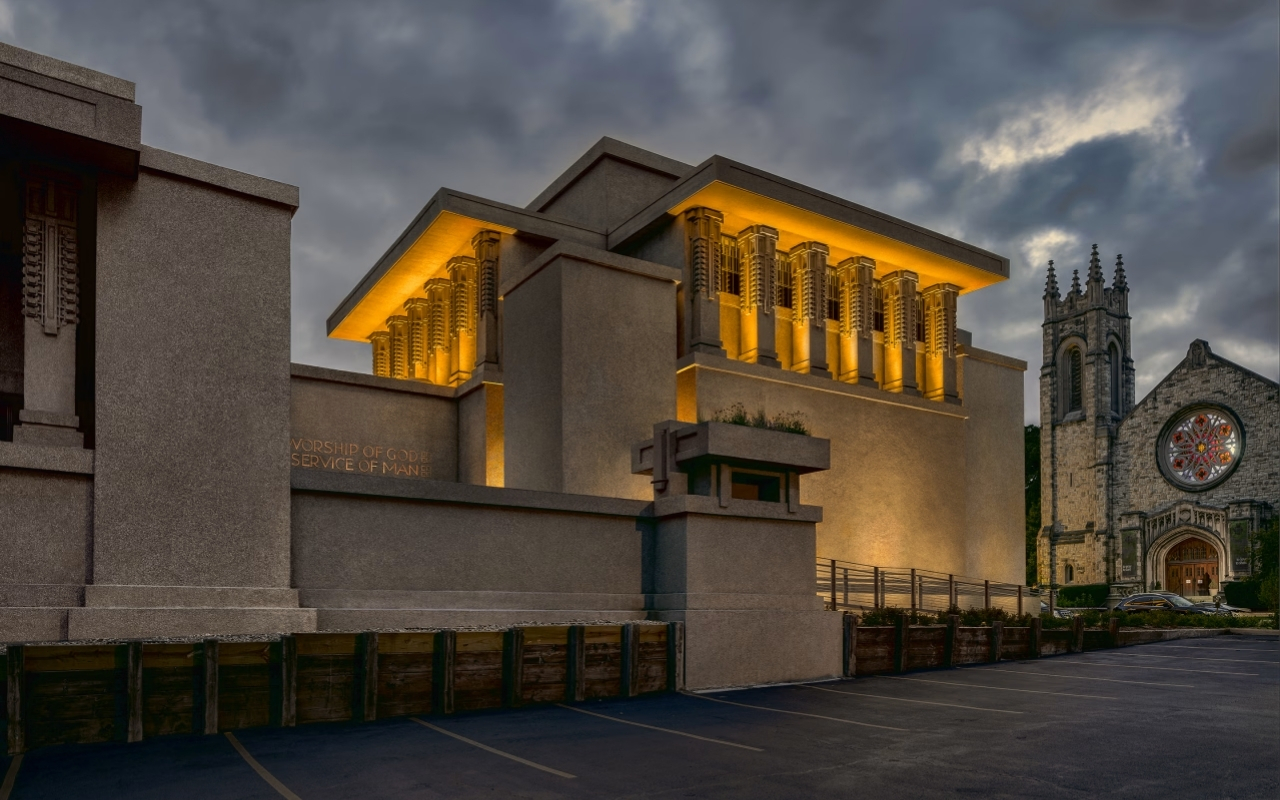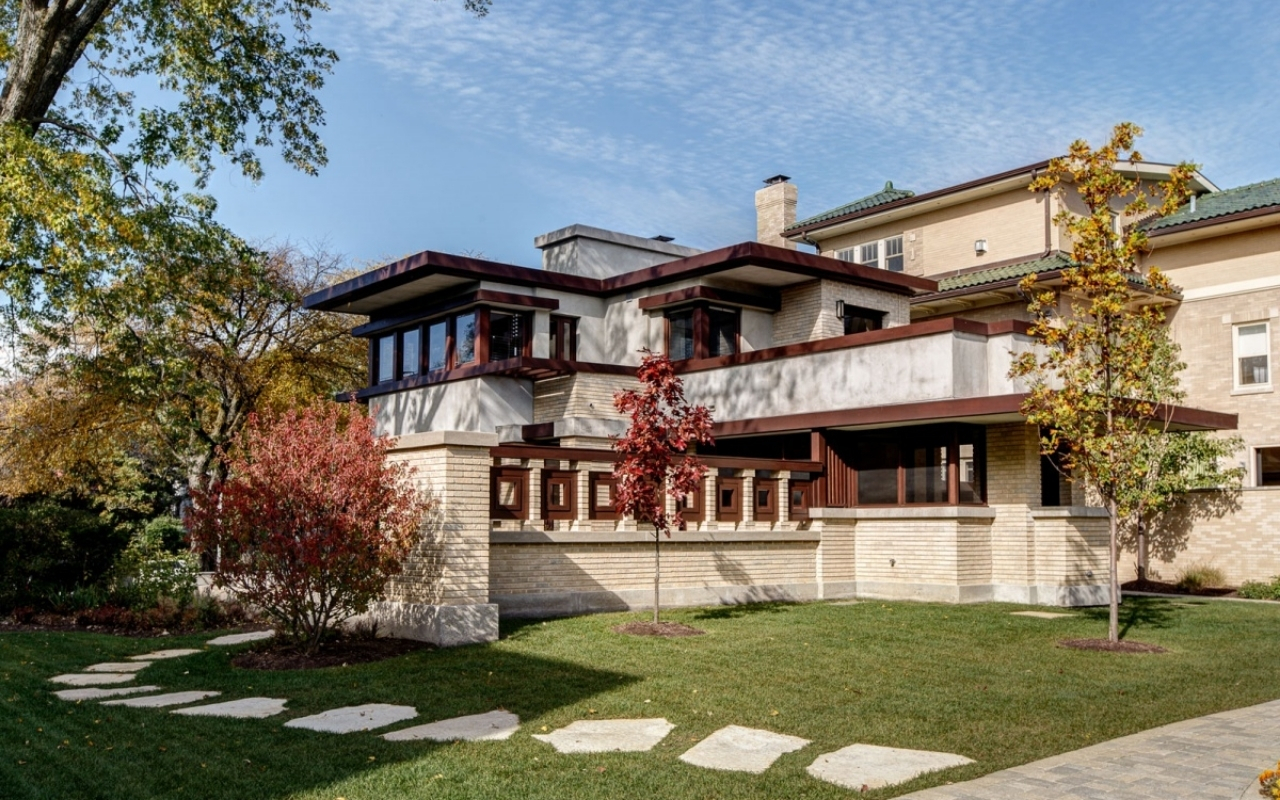
The Birth of the Prairie School in Chicago
Frank Lloyd Wright arrived in Chicago in 1887, a young draftsman seeking opportunity in a city rebuilding after the Great Fire. The timing couldn't have been more fortuitous. Chicago was becoming an architectural laboratory, and Wright soon found himself working under Louis Sullivan, known as the "father of modernism."
By the late 1890s, Wright had established his own practice and begun developing what would become known as the Prairie School style- a distinctly American architectural language that rejected the ornate European styles dominating American architecture.
Must-Visit Wright Sites in Chicago and Oak Park
The Frederick C. Robie House (Chicago)

Completed in 1910, the Robie House in Hyde Park stands as perhaps the finest example of Wright's mature Prairie style. Its dramatic horizontal planes, continuous bands of art glass windows, and integrated furnishings exemplify Wright's concept of "organic architecture." The home's cantilevered roofs and open interior spaces were revolutionary for their time.
Guided tours offer access to the interior spaces where Wright's genius for spatial design is most evident. Morning visits provide the best light to appreciate the stunning art glass windows.
The Studio and Home (Oak Park)

Wright's own home and studio, built in 1889 and expanded in 1898, served as his laboratory for architectural ideas. Here, you can see the evolution of Wright's thinking and the workplace where he designed over 150 buildings during his first 20 years of practice. The drafting room with its chain-suspended balcony showcases Wright's innovative structural thinking.
The home reveals Wright's experimental nature as he constantly modified the building to test architectural concepts that would later become hallmarks of his style.Get Directions
Unity Temple (Oak Park)

Completed in 1908, Unity Temple was revolutionary in its use of reinforced concrete as both structural and decorative elements. The building's cubic masses, absence of traditional church elements like steeples, and innovative interior lighting make it one of Wright's most forward-thinking designs. Inside, the space evokes a sense of serenity through carefully controlled natural light and balanced proportions.
Unity Temple's recent $25 million restoration has returned the building to its original glory. The interior light courts and clerestory windows create an ever-changing play of light throughout the day.
Emil Bach House (Chicago)

This compact 1915 home represents Wright's late Prairie period and offers a more intimate version of his design principles. Its geometric forms and integration with the landscape show Wright's genius in adapting his style to urban residential lots. The home's restored interior showcases Wright's integrated design approach, with built-in furniture and characteristic art glass.
Unlike many Wright properties, the Emil Bach House can be rented for overnight stays, offering a rare opportunity to experience living in a Wright-designed space.
The Rookery Building Lobby (Chicago Loop)

Though not a Wright building, his 1905 redesign of this atrium space showcases how he could transform existing architecture with his distinctive style. The blend of marble, gilded ironwork, and Wright's signature geometric patterns creates a stunning public space. Wright's intervention respected the original structure while infusing it with his modern sensibility.
Get DirectionsDefining Features of Wright's Prairie Style
The Prairie style wasn't merely an aesthetic choice—it was Wright's philosophical response to the American Midwest's landscape and democratic ideals. Wright created a cohesive design language with several key elements:
- Horizontal Lines: Low-pitched roofs with broad, overhanging eaves and strong horizontal profiles that mirror the flat prairie landscape.
- Open Floor Plans: Flowing, interconnected spaces that rejected compartmentalized Victorian rooms and promoted family interaction.
- Integration with Nature: Large windows, natural materials, and designs that blend with the surrounding landscape, reflecting Wright's belief in harmony with nature.
- Geometric Abstraction: Geometric patterns and abstract designs in windows, light fixtures, and furniture that were integral to the overall architectural expression.
"The reality of the building is not in the solid elements themselves, but in the space created by them." - Frank Lloyd Wright
Frank Lloyd Wright Architectural Guide
| Building | Location | Year | Notable Features |
|---|---|---|---|
| Robie House | 5757 S. Woodlawn Ave, Chicago | 1910 | Quintessential Prairie style, horizontal emphasis, art glass windows |
| Wright Home & Studio | 951 Chicago Ave, Oak Park | 1889/1898 | Wright's personal residence and workspace, experimental design elements |
| Unity Temple | 875 Lake St, Oak Park | 1908 | Innovative concrete construction, intricate light screens, geometric forms |
| Emil Bach House | 7415 N. Sheridan Rd, Chicago | 1915 | Compact urban Prairie design, now available for tours and overnight stays |
| The Rookery Lobby | 209 S. LaSalle St, Chicago | 1905 | Wright's reinterpretation of existing architecture, light court |
| Arthur Heurtley House | 318 Forest Ave, Oak Park | 1902 | Early mature Prairie style, Roman brick construction |
| Frank W. Thomas House | 210 Forest Ave, Oak Park | 1901 | First true Prairie style house, geometric art glass |
Explore these iconic buildings to experience the evolution of Wright's revolutionary Prairie style architecture throughout Chicago and Oak Park.
Beyond the Buildings: Wright's Influence on Chicago
Wright's impact extends beyond individual buildings. His innovations helped establish Chicago as an architectural center and influenced generations of architects who followed him. The "Chicago School" of architecture, with its emphasis on function, structure, and modern materials, owes much to Wright's pioneering work.
In Oak Park, Wright's presence transformed a suburban village into an architectural destination. Today, the largest collection of Wright-designed buildings in the world can be found within walking distance of each other, creating an unparalleled opportunity to experience the evolution of his Prairie style.
Experiencing Wright's Architecture Today
I still remember my first visit to the Robie House- how the low ceilings of the entrance suddenly gave way to the expansive living space, creating a dramatic sense of release. Standing in that room, with light filtering through the art glass windows and casting geometric patterns across the space, I understood why Wright's work continues to captivate us.
Most Wright buildings in Chicago and Oak Park offer public tours, with some providing specialized experiences:
- The Frank Lloyd Wright Trust operates regular tours of the Robie House, Home and Studio, Unity Temple, and other significant Wright buildings.
- The Emil Bach House can be rented for overnight stays, offering a unique opportunity to live in a Wright space.
- Self-guided walking tours of Oak Park allow visitors to see over 25 Wright-designed structures from the exterior.
- Annual Wright Plus Housewalk provides rare access to private Wright homes that are typically closed to the public.
Preserving Wright's Legacy
Maintaining these architectural treasures presents constant challenges. Many Wright buildings have undergone extensive restoration to address structural issues, update systems, and reverse inappropriate alterations.
Unity Temple recently completed a $25 million restoration that returned the building to its original glory while incorporating modern climate control systems to protect it for future generations. Similarly, the Robie House underwent a comprehensive restoration completed in 2019, revealing Wright's original vision that had been obscured by decades of modifications.
These preservation efforts ensure that Wright's revolutionary ideas continue to inspire and challenge us, just as they did when first unveiled to a stunned public over a century ago.
Wright's Continuing Relevance
What makes Wright's Chicago and Oak Park buildings so remarkable is not just their historical significance but their continuing relevance. His emphasis on open plans, connection to nature, and honest use of materials feels remarkably contemporary.
Modern sustainable design owes much to Wright's principles of working with the environment rather than against it. His innovative use of materials and construction techniques pushed architectural boundaries in ways that continue to influence how we build today.
As our cities face new challenges of sustainability, community, and identity, Wright's visionary work in Chicago and Oak Park offers valuable lessons in creating architecture that reflects American values while embracing innovation. Over a century later, the Prairie School remains not just a historical style but a living source of inspiration for those seeking to create meaningful, integrated design.
Images courtesy of Frank Lloyd Wright Trust and Chicago Architecture Center. Information sourced from architectural archives and personal visits to these remarkable structures.
Explore Wright's Architecture While We Clean Your Home
Visit Chicago's architectural treasures without worrying about housework. Our professional cleaning team will maintain harmony and order in your space while you experience Wright's Prairie-style masterpieces.
Book our services




0 Comments